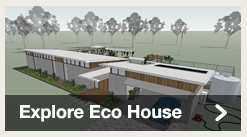Build it Back Greenbushfires
Mudbrick
 Mudbricks are pretty much what they sound like -
bricks made of mud. Often, they are made on site from local soil,
providing there is enough clay content. The soil is mixed with
water and reinforcing materials such as straw and even cement and
then pressed into wooden forms and allowed to set. The forms are
removed and the bricks set aside to dry for up to several weeks. As
they are made from natural materials they are a sustainable,
recyclable, non-toxic and healthy form of building
construction.
Mudbricks are pretty much what they sound like -
bricks made of mud. Often, they are made on site from local soil,
providing there is enough clay content. The soil is mixed with
water and reinforcing materials such as straw and even cement and
then pressed into wooden forms and allowed to set. The forms are
removed and the bricks set aside to dry for up to several weeks. As
they are made from natural materials they are a sustainable,
recyclable, non-toxic and healthy form of building
construction.
When building, mudbricks require suitable footings such as a course of regular fired bricks or concrete footings or slab. They are held together with a mud mortar mixture which is similar in composition to the mudbrick mixture itself. Mudbricks, being soft and unfired, are easy to cut with hand tools, and can be formed into interesting shapes.
Once laying of the bricks is finished and the mortar is dry, the brick walls are often rendered with cement or mud-based renders, although many mudbrick walls are left au-naturale or are sealed with a transparent water-based sealant to improve weather resistance.
Mudbricks have many advantages, including low cost and low embodied energy (especially if they are made on site and not transported long distances) and ease of use. They also have high thermal mass (the ability to store and release heat), if the bricks are a minimum of 300mm thick.
Earth buildings have excellent fire ratings which makes them suitable for building in bushfire prone areas and for the construction of fire rated walls within buildings. When designing new buildings consider using low pitched or curved roofs and parapet walls to reduce the impact of radiant heat and possibility of embers entering the roof area.
The drawbacks of mudbricks are, they are easily damaged, especially by rain and wind if not protected, and have high weight, making working with them a strenuous exercise if using larger bricks, which is quite common. They also are not good thermal insulators however insulation can be added to mudbrick walls with linings. However they are excellent sound insulators.
Mudbricks are pretty much what they sound like - bricks made of mud. Often, they are made on site from local soil, providing there is enough clay content. The soil is mixed with water and reinforcing materials such as straw and even cement and then pressed into wooden forms and allowed to set. The forms are removed and the bricks set aside to dry for up to several weeks. As they are made from natural materials they are a sustainable, recyclable, non-toxic and healthy form of building construction.
When building, mudbricks require suitable footings such as a course of regular fired bricks or concrete footings or slab. They are held together with a mud mortar mixture which is similar in composition to the mudbrick mixture itself. Mudbricks, being soft and unfired, are easy to cut with hand tools, and can be formed into interesting shapes.
Once laying of the bricks is finished and the mortar is dry, the brick walls are often rendered with cement or mud-based renders, although many mudbrick walls are left au-naturale or are sealed with a transparent water-based sealant to improve weather resistance.
Mudbricks have many advantages, including low cost and low embodied energy (especially if they are made on site and not transported long distances) and ease of use. They also have high thermal mass (the ability to store and release heat), if the bricks are a minimum of 300mm thick.
Earth buildings have excellent fire ratings which makes them suitable for building in bushfire prone areas and for the construction of fire rated walls within buildings. When designing new buildings consider using low pitched or curved roofs and parapet walls to reduce the impact of radiant heat and possibility of embers entering the roof area.
The drawbacks of mudbricks are, they are easily damaged, especially by rain and wind if not protected, and have high weight, making working with them a strenuous exercise if using larger bricks, which is quite common. They also are not good thermal insulators however insulation can be added to mudbrick walls with linings. However they are excellent sound insulators.
Suppliers
Amcer - www.amcer.com.au
Ph. 03 9714 8688
Mudbrick Circus - www.mudbrickcircus.com.au
Ph. 03 5422 1808
Listed suppliers are a guide and are not endorsed by Green Cross Australia or the Alternative Technology Association.


